Related Research Articles
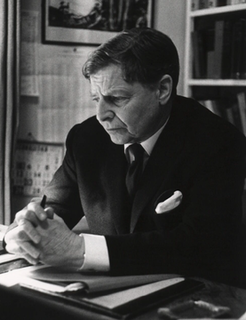
John Innes Mackintosh Stewart was a Scottish novelist and academic. He is equally well known for the works of literary criticism and contemporary novels published under his real name and for the crime fiction published under the pseudonym of Michael Innes.

Hamlet, Revenge! is a 1937 detective novel by Michael Innes, his second novel. It centres on the investigation into the murder of the Lord Chancellor of England during an amateur production of Shakespeare's Hamlet, in which he plays Polonius, and other crimes which follow at the seat of the Duke of Horton, Scamnum Court.

Mr. Denning Drives North is a 1950 thriller novel by the British-Australian writer Alec Coppel. When successful and happily married aircraft manufacturer Tom Denning attempts to commit suicide by crashing a plane, detectives uncover a murder in his past background that has driven him insane with guilt.

Dead Men's Morris is a 1936 mystery detective novel by the British writer Gladys Mitchell. It is the seventh in her long-running series featuring the psychoanalyst and amateur detective Mrs Bradley. It was the first to be published by Michael Joseph who released all the subsequent fifty nine novels in the series. It was later republished with the alternative title Death Comes at Christmas.

G-Man at the Yard is a 1946 thriller novel by the British writer Peter Cheyney. It is the final entry in the popular series of novels featuring the FBI agent Lemmy Caution. It was republished posthumously in 1953 following his death in 1951, now also including three short stories. Unlike many other novels by Cheyney it was never made into a film.

I'll Say She Does is a 1945 thriller novel by the British writer Peter Cheyney. It is the tenth in his series of novels featuring the FBI agent Lemmy Caution. Later editions of the book are generally titled I'll Say She Does!
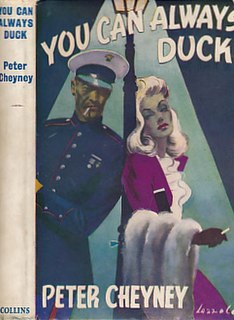
You Can Always Duck is a 1943 thriller novel by the British writer Peter Cheyney. It is the ninth in his series of novels featuring the FBI agent Lemmy Caution. The action takes place in wartime London where Caution is on the trail of a gang of black marketeers who have got mixed up in espionage. It was one of a number of films and novels of the period that made use of the booming black market for their setting.

Never a Dull Moment is a 1942 thriller novel by the British writer Peter Cheyney. It is the eight in his series of novels featuring the FBI agent Lemmy Caution. Cheyney had become known for his hardboiled style, similar to that of Raymond Chandler.

Your Deal, My Lovely is a 1941 thriller novel by the British writer Peter Cheyney. It is the seventh in his series of novels featuring the FBI agent Lemmy Caution. Much of the action takes place in wartime London. Caution is called in to investigate the disappearance of a prominent scientist.

You'd Be Surprised is a 1940 thriller novel by the British writer Peter Cheyney. It is the sixth in his series of novels featuring the FBI agent Lemmy Caution. Unlike several of the others it has not been adapted for film.

Uneasy Terms is a 1946 crime thriller novel by the British writer Peter Cheyney. It was the seventh and last in his series featuring the London-based private detective Slim Callaghan, a British version of the hardboiled heroes of American writing.

The Mystery of the Open Window is a 1929 mystery detective novel by Anthony Gilbert, the pen name of British writer Lucy Beatrice Malleson. It is the fourth novel in a series featuring her amateur detective, the politician Scott Egerton. Unlike the rest of the series it was published by Gollancz rather than Collins. It takes the form of a locked room mystery, a popular branch of the genre during the Golden Age of Detective Fiction.
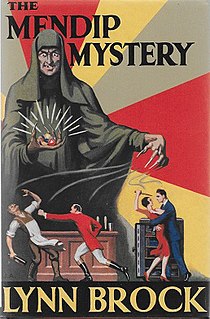
The Mendip Mystery is a 1929 mystery detective novel by the Irish-born writer Lynn Brock. It was the fifth of seven novels in his series featuring the character of Colonel Wyckham Gore, one of the most prominent investigators during the early stages of the Golden Age of Detective Fiction. It was published in America with the alternative title of Murder at the Inn.
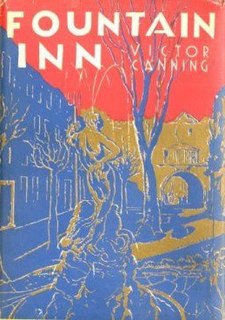
Fountain Inn is a 1939 mystery detective novel by the British writer Victor Canning. Canning had made his name with his comedy novels featuring Mr. Finchley. This was his first attempt at a thriller, but after the war he increasingly switched to writing thrillers. It received positive reviews with The Guardian noting "Fountain Inn, which is extremely well written, is the attractive kind of detective story in which the main interest is not “Who?” but “How?”". The first edition was by Hodder and Stoughton, but there was a reissue in 1974 by Heinemann, and it was republished in 2019 by Farrago Books.

A Village Afraid is a 1950 detective novel by the British writer Cecil Street, writing under the pen name of Miles Burton. It was part of a lengthy series of books featuring the detective Desmond Merrion and Inspector Arnold of Scotland Yard.
The Secret Meeting is a 1951 detective novel by John Rhode, the pen name of the British writer Cecil Street. It is the fifty second in his long-running series of novels featuring Lancelot Priestley, a Golden Age armchair detective. It was published in America the same year by Dodd Mead. Unusually for the series it has an early Cold War element.
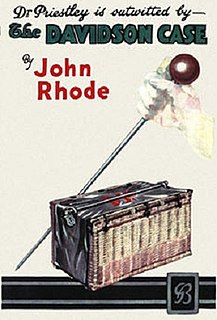
The Davidson Case is a 1929 detective novel by John Rhode, the pen name of the British writer Cecil Street. It was the seventh appearance of the armchair detective Lancelot Priestley, who featured in a long-running series of novels during the Golden Age of Detective Fiction.

A Night of Errors is a 1947 detective novel by the British writer Michael Innes. It is the eleventh in his series featuring John Appleby, recently a Detective Inspector in the Metropolitan Police but currently living in an early retirement in the English countryside. It takes the form of a country house mystery with an extremely complex plot, laced with strong elements of farce common throughout the series.

Appleby's End is a 1945 detective novel by the British writer Michael Innes. It is the tenth in his series featuring John Appleby, a young Detective Inspector in the Metropolitan Police. The plot has some similarities to a country house mystery taking part in rural England, but as with much of the author's work this is mixed with a complex plot and a variety of farcical incidents and characters. As is common for novels in the genre, no mention is made of the ongoing Second World War. Taking place over little more than twenty four hours, it ends with Appleby engaged to be married and planning to retire from the police force.
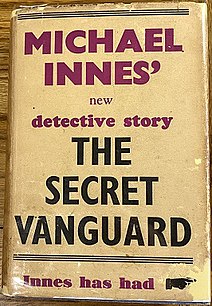
The Secret Vanguard is a 1940 thriller novel by the British writer Michael Innes. It is the fifth in his series featuring John Appleby, a young Detective Inspector in the Metropolitan Police. The novel takes place in the early stages of the Second World War, and functions closer to a mystery spy novel than the traditional detective novel.
References
- ↑ Reilly p.845